Water Transport through Cracked Concrete Structures—Effect of Mixture Proportion on Separating Crack Geometry and Permeability
Abstract
:1. Introduction
2. Materials and Methods
2.1. Concrete Mixture Proportion
2.2. Preparation and Cracking of Samples
2.3. Permeation Tests
2.4. Determination of Crack Geometry
2.5. Parameters Characterizing the Crack Geometry
3. Results and Discussion
3.1. Surface-Crack Width
3.2. Tortuosity and Crack Width Ratio
3.2.1. Tortuosity
3.2.2. Crack-Width Ratio
3.3. Flow Rate
4. Conclusions
- A literature review revealed that the crack width is an ambiguous definition. It can be determined with different measuring methods and partly at locations deviating from the direct sample surface. Therefore, for the purpose of comparability, the measuring method and the measuring location must be reported when specifying the crack width;
- The use of microcomputed tomography (µCT) has great potential for the non-destructive determination of crack geometry. In addition to simple visualization, further processing of the µCT data is possible to determine the crack geometry inside the sample quantitatively. However, difficulties in the analysis of µCT scans involve areas of similar grey levels, as it is not straightforward to distinguish between different materials;
- µCT data give higher surface-crack widths wsur,m than the crack-width ruler and digital microscope, with the crack-width ruler and digital microscope being in the same range. If only the surface-crack width is necessary, a digital microscope is recommended;
- The evaluation of µCT scans shows a clear difference between the mean surface-crack width and the inner-crack width win(x,z) or minimal mean inner-crack width min. win,m. In most cases, inner-crack widths are significantly smaller than mean surface-crack width (CWR < 1). This significantly smaller inner-crack width is likely to result in a significantly lower permeability than would be expected based on the surface-crack width. The effect of the varying crack geometry inside a concrete member is therefore of great importance for prediction models;
- For natural round aggregates, an increasing aggregate size results in an increase of tortuosity and a decrease of permeability for a given crack width. With increasing tortuosity, the flow length and the changes in flow direction increase, which results in reduced permeability;
- The use of angular aggregate tends to result in smaller crack-width ratios, i.e., a stronger narrowing of the cracks inside the component. However, at a given inner-crack width, concrete mixes with angular aggregates show slightly higher flow rates than mixes with round aggregates. The tortuosities of both aggregate shapes are in a similar range;
- For w/c-ratio, cement type and aggregate gradation, we could not determine any clear effects on tortuosity and flow rate. Although a higher w/c-ratio appears to increase tortuosity and to reduce CWR, no effect was seen in flow-rate experiments;
- The aforementioned findings regarding the effects of various mixture parameters can be used to refine or redevelop predictive models for the flow through separating cracks. In particular the consideration of tortuosity and crack-width ratio could be beneficial;
- Furthermore, the results can be used for the development of an optimal concrete mixture. The results imply that the use of aggregates with a large maximum grain size can reduce the crack permeability.
Author Contributions
Funding
Institutional Review Board Statement
Informed Consent Statement
Data Availability Statement
Conflicts of Interest
References
- Shaikh, F.U.A. Effect of Cracking on Corrosion of Steel in Concrete. Int. J. Concr. Struct. Mater. 2018, 12, 3. [Google Scholar] [CrossRef]
- Jones, S.; Martys, N.; Lu, Y.; Bentz, D. Simulation studies of methods to delay corrosion and increase service life for cracked concrete exposed to chlorides. Cem. Concr. Compos. 2015, 58, 59–69. [Google Scholar] [CrossRef]
- Ji, Y.; Hu, Y.; Zhang, L.; Bao, Z. Laboratory studies on influence of transverse cracking on chloride-induced corrosion rate in concrete. Cem. Concr. Compos. 2016, 69, 28–37. [Google Scholar] [CrossRef]
- Hornbostel, K.; Larsen, C.K.; Geiker, M.R. Relationship between concrete resistivity and corrosion rate—A literature review. Cem. Concr. Compos. 2013, 39, 60–72. [Google Scholar] [CrossRef]
- EN 12390-8:2009; DIN Deutsches Institut für Normung e.V. Prüfung von Festbeton—Teil 8: Wassereindringtiefe unter Druck. Deutsche Fassung; Beuth: Berlin, Germany, 2009. (In German)
- ASTM D5084-16a; Standard Test Methods for Measurement of Hydraulic Conductivity of Saturated Porous Materials Using Flexible Wall Permeameter. ASTM International: West Conshohocken, PA, USA, 2016.
- Šavija, B.; Luković, M.; Schlangen, E. Influence of Cracking on Moisture Uptake in Strain-Hardening Cementitious Composites. J. Nanomech. Micromech. 2017, 7, 1–8. [Google Scholar] [CrossRef]
- Zhang, P.; Zhao, T.J.; Zhang, L.S.; Wittmann, F.H.; Lehmann, E.; Vontobel, P. Application of Neutron Radiography to Observe Water Absorbtion of Concrete. In Proceedings of the 18th International Conference on Nuclear Engineering, Xi’an, China, 17–21 May 2010; Volume 3. [Google Scholar]
- Pease, B.; Couch, J.; Geikler, M.; Stang, H.; Weiss, J. Assessing the Portion of the Crack Length Contribution to Water Sorption in Concrete Using X-ray Absorption. In Proceedings of the ConcreteLife’09: Second International RILEM Workshop on Concrete Durability and Service Life Planning, Haifa, Israel, 1 January 2009. [Google Scholar]
- Akhavan, A.; Shafaatian, S.-M.-H.; Rajabipour, F. Quantifying the effects of crack width, tortuosity, and roughness on water permeability of cracked mortars. Cem. Concr. Res. 2012, 42, 313–320. [Google Scholar] [CrossRef]
- Wang, K.; Igusa, T.; Shah, S.P. Permeability of concrete—Relationships to its mix proportion, microstructure and microcracks. In Proceedings of the Sidney Diamond symposium; Cohen, M., Mindess, S., Skalny, J., Eds.; The American Ceramic Society: Westerville, OH, USA, 1998; pp. 45–54. [Google Scholar]
- Princigallo, A. Study on Permeability of Cracked Concrete. ACI Mater. J. 2020, 117, 151–164. [Google Scholar]
- Aldea, C.-M.; Ghandehari, M.; Shah, S.P.; Karr, A. Combined effect of cracking and water permeability of concrete. In Proceedings of the EM 2000: Fourteenth Engineering Mechanics Conference, Austin, TX, USA, 21–24 May 2000. [Google Scholar]
- Aldea, C.-M.; Shah, S.P.; Karr, A. Permeability of cracked concrete. Mater. Struct. 1999, 32, 370–376. [Google Scholar] [CrossRef]
- Aldea, C.-M.; Surendra, P.S.; Karr, A. Effect of Cracking on Water and Chloride Permeability of Concrete. J. Mater. Civ. Eng. 1999, 11, 181–187. [Google Scholar] [CrossRef]
- Ripphausen, B. Investigations of the Water Permeability and Repair of Reinforced Concrete Structures with through Cracks. Ph.D. Thesis, Technische Hochschule Aachen, Aachen, Germany, 1989. (In German). [Google Scholar]
- Wang, K.; Jansen, D.C.; Shah, S.P.; Karr, A.F. Permeability study of cracked concrete. Cem. Concr. Res. 1997, 27, 381–393. [Google Scholar] [CrossRef]
- Hornig, U.; Zietmann, N.; Dehn, F. Final Report 15001-007; MFPA Leipzig GmbH: Leipzig, Germany, 2013. (In German) [Google Scholar]
- Imhof-Zeitler, C. Flow Behaviour of Various Liquids in Through-Cracked Concrete Structures; Beuth: Berlin, Germany; Wien, Austria; Zürich, Switzerland, 1996. (In German) [Google Scholar]
- Rapoport, J.; Aldea, C.; Shah, S.; Ankenman, B.; Karr, A. Permeability of Cracked Steel Fiber-Reinforced Concrete. J. Mater. Civ. Eng. 2002, 14, 355–358. [Google Scholar] [CrossRef]
- Meichsner, H.; Wünschig, R. The Self-Healing of Cracks in Concrete and Reinforced Concrete Structures; IRB Verlag: Stuttgart, Germany, 1991. (In German) [Google Scholar]
- Schlangen, E.; Heide, N.t.; van Breugel, K. Crack healing of early age cracks in concrete. In Measuring, Monitoring and Modeling Concrete Properties: An International Symposium Dedicated to Surendra P. Shah, Northwestern University, USA; Konsta-Gdoutos, M.S., Shah, S.P., Eds.; Springer: Dordrecht, The Netherlands, 2006; pp. 273–284. [Google Scholar]
- Van Tittelboom, K.; de Belie, N. Self-Healing in Cementitious Materials—A Review. Materials 2013, 6, 2182–2217. [Google Scholar] [CrossRef]
- Granger, S.; Loukili, A.; Pijaudier-Cabot, G.; Chanvillard, G. Experimental characterization of the self-healing of cracks in an ultra high performance cementitious material: Mechanical tests and acoustic emission analysis. Cem. Concr. Res. 2007, 37, 519–527. [Google Scholar] [CrossRef]
- Clear, C.A. The Effects of Autogenous Healing upon the Leakage of Water through Cracks in Concrete; Technical Report 559; Wexham Springs: Slough, UK, 1985. [Google Scholar]
- Edvardsen, C.K. Water Permeability and Self-Healing of through Cracks; Beuth: Berlin, Germany, 1996. (In German) [Google Scholar]
- Van Tittelboom, K.; de Belie, N.; van Loo, D.; Jacobs, P. Self-healing efficiency of cementitious materials containing tubular capsules filled with healing agent. Cem. Concr. Compos. 2011, 33, 497–505. [Google Scholar] [CrossRef]
- Ferrara, L.; Krelani, V.; Carsana, M. A “fracture testing” based approach to assess crack healing of concrete with and without crystalline admixtures. Constr. Build. Mater. 2014, 68, 535–551. [Google Scholar] [CrossRef]
- Wiktor, V.; Jonkers, H.M. Quantification of crack-healing in novel bacteria-based self-healing concrete. Cem. Concr. Compos. 2011, 33, 763–770. [Google Scholar] [CrossRef]
- Snoeck, D.; van den Heede, P.; van Mullem, T.; de Belie, N. Water penetration through cracks in self-healing cementitious materials with superabsorbent polymers studied by neutron radiography. Cem. Concr. Res. 2018, 113, 86–98. [Google Scholar] [CrossRef]
- Tammo, K.; Thelandersson, S. Crack opening near reinforcement bars in concrete structures. Struct. Concr. 2006, 7, 137–143. [Google Scholar] [CrossRef]
- Zhang, P.; Wittmann, F.H.; Lura, P.; Müller, H.S.; Han, S.; Zhao, T. Application of neutron imaging to investigate fundamental aspects of durability of cement-based materials: A review. Cem. Concr. Res. 2018, 108, 152–166. [Google Scholar] [CrossRef]
- Picandet, V.; Khelidj, A.; Bellegou, H. Crack effects on gas and water permeability of concretes. Cem. Concr. Res. 2009, 39, 537–547. [Google Scholar] [CrossRef]
- Rastiello, G.; Boulay, C.; Dal Pont, S.; Tailhan, J.L.; Rossi, P. Real-time water permeability evolution of a localized crack in concrete under loading. Cem. Concr. Res. 2014, 56, 20–28. [Google Scholar] [CrossRef]
- Ahmad, S.; Azad, A.K.; Loughlin, K.F. Effect of key mixture parameters on tortuosity and permeability of concrete. J. Adv. Concr. Technol. 2012, 10, 86–94. [Google Scholar] [CrossRef]
- Bear, J. Dynamics of Fluids in Porous Media; American Elsevier Publishing: New York, NY, USA, 1972. [Google Scholar]
- Praticò, F.G.; Vizzari, D.; Fedele, R. Estimating the resistivity and tortuosity of a road pavement using an inverse problem approach. In Proceedings of the 24th International Congress on Sound and Vibration, London, UK, 23–27 July 2017. [Google Scholar]
- Cao, T.; Zhang, L.; Sun, G.; Wang, C.; Zhang, Y.; Yan, N.; Xu, A. Model for Predicting the Tortuosity of Transport Paths in Cement-Based Materials. Materials 2019, 12, 3623. [Google Scholar] [CrossRef]
- Meichsner, H. Self-Healing of Cracks in Conrete Structures; FE Bericht zur FE-Aufgabe Nr. 7422.2; Wexham Springs: Slough, UK, 1990. (In German) [Google Scholar]
- Tsukamoto, M. Investigations on Permeability of Fibre-Free and Fibre-Reinforced Concrete Components with Separating Cracks. Ph.D. Thesis, TH Darmstadt, Darmstadt, Germany, 1991. (In German). [Google Scholar]
- Darma, I.S.; Sugiyama, T.; Promentilla, M.A.B. Application of X-Ray CT Study Diffusivity in Cracked Concrete through the Observation of Tracer Transport. J. Adv. Concr. Technol. 2013, 11, 266–281. [Google Scholar] [CrossRef]
- Husain, S.I.; Ferguson, P.M. Flexural Crack Widths at the Bars in Reinforced Concrete Beams; Summary Report 102-IF (S); Center for Highway Research The University of Texas: Austin, TX, USA, 1968. [Google Scholar]
- Beeby, A.W. The influence of the parameter ϕ/ρeff on crack widths: Discussion. Struct. Concr. 2005, 6, 156–165. [Google Scholar] [CrossRef]
- Yannopoulos, P. Variation of concrete crack widths through the concrete to reinforcement. Mag. Concr. Res. 1989, 41, 63–68. [Google Scholar] [CrossRef]
- Boverket, S. Boverkets Handbok om Betonkonstrktioner: BBK04, 3rd ed.; Boverket: Karlskrona, Sweden, 2004. (In Swedish) [Google Scholar]
- Empelmann, M.; Busse, D. Vergleich von normativen Modellen zur Berechnung der Rissbreite. Beton-Stahlbetonbau 2018, 113, 298–306. [Google Scholar] [CrossRef]
- FIB. Model Code 2010: First Complete Draft; International Federation for Structural Concrete (FIB): Lausanne, Switzerland, 2010. [Google Scholar]
- Poiseuille, J.L.M.; Herschel, W.H. Experimental Investigations upon the Flow of Liquids in Tubes of Very Small Diameter; Lancaster Press Inc.: Lancaster, UK, 1940. [Google Scholar]
- Wagner, C. Durability Related Properties of Strain Hardening Cement-Based Repair Layers on Cracked Concrete Substrates; Schriftenreihe des Instituts für Baustoffe Heft 2016/2; Instituts für Baustoffe Heft: Dresden, Germany, 2016. (In German) [Google Scholar]
- De Chiffre, L.; Carmignato, S.; Kruth, J.-P.; Schmitt, R.; Weckenmann, A. Industrial applications of computed tomography. CIRP Ann.-Manuf. Technol. 2014, 63, 655–677. [Google Scholar] [CrossRef]
- Buzug, T.M. Computed Tomography; Springer: Berlin/Heidelberg, Germany, 2008. [Google Scholar]
- Skarżyński, Ł.; Tejchman, J. Experimental Investigations of Fracture Process in Concrete by Means of X-ray Micro-computed Tomography. Strain 2016, 52, 26–45. [Google Scholar] [CrossRef]
- Paetsch, O.; Baum, D.; Breßler, D.; Ehrig, K.; Meinel, D.; Prohaska, S. 3-D-Visualisierung und statistische Analyse von Rissen in mit Computer-Tomographie untersuchten Betonproben. In Proceedings of the DGZfP-Jahrestagung, Dresden, Germany, 6–8 May 2013. (In German). [Google Scholar]
- Michel, A.; Pease, B.J. Moisture ingress in cracked cementitious materials. Cem. Concr. Res. 2018, 113, 154–168. [Google Scholar] [CrossRef]
- DIN 1045-2; Tragwerke aus Beton, Stahlbeton und Spannbeton—Teil 2: Beton—Festlegung, Eigenschaften, Herstellung und Konformität—Anwendungsregeln zu DIN EN 206, 2014, ICS 91.080.40. Beuth: Berlin, Germany, 2008. (In German)
- DIN EN 196-1; Methods of Testing Cement Part 1: Determination of Strength; German version EN 196-1:2016. Beuth: Berlin, Germany, 2016.
- Li, V.C.; Yang, E.-H. Self Healing in Concrete Materials. In Self Healing Materials: An Alternative Approach to 20 Centuries Materials Science; van der Zwaag, S., Ed.; Springer: Dordrecht, The Netherlands, 2007. [Google Scholar]
- Zemann, M.; Herrmann, N.; Willers, K.; Gerlach, L.; Müller, H. Cracks in concrete containment—Comparing the self-healing potential under variable air steam loads between real scale and laboratory scale. In Proceedings of the 24rd Conference on Structural Mechanics in Reactor Technology, Busan, South Korea, 20–25 August 2017. [Google Scholar]
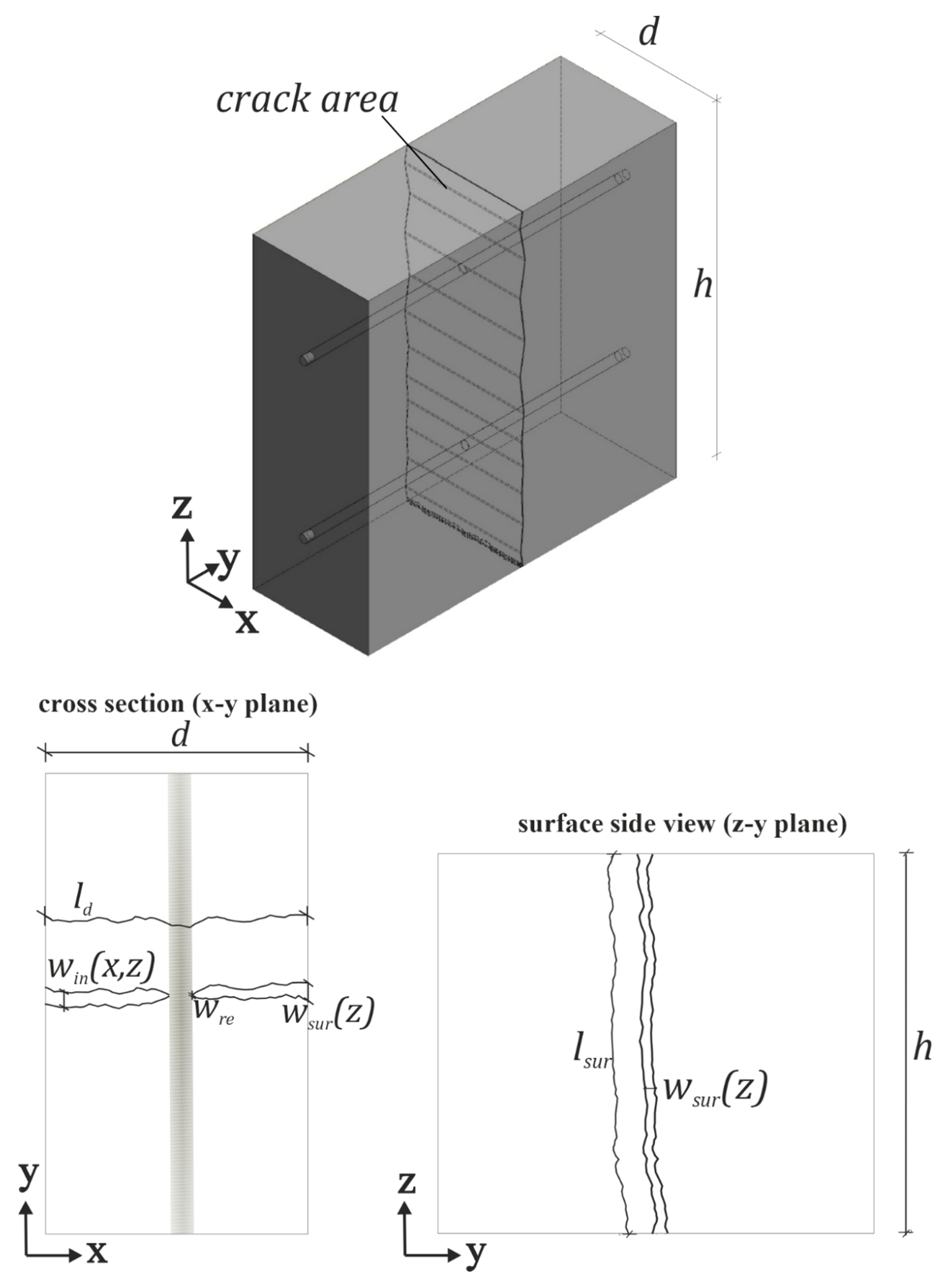

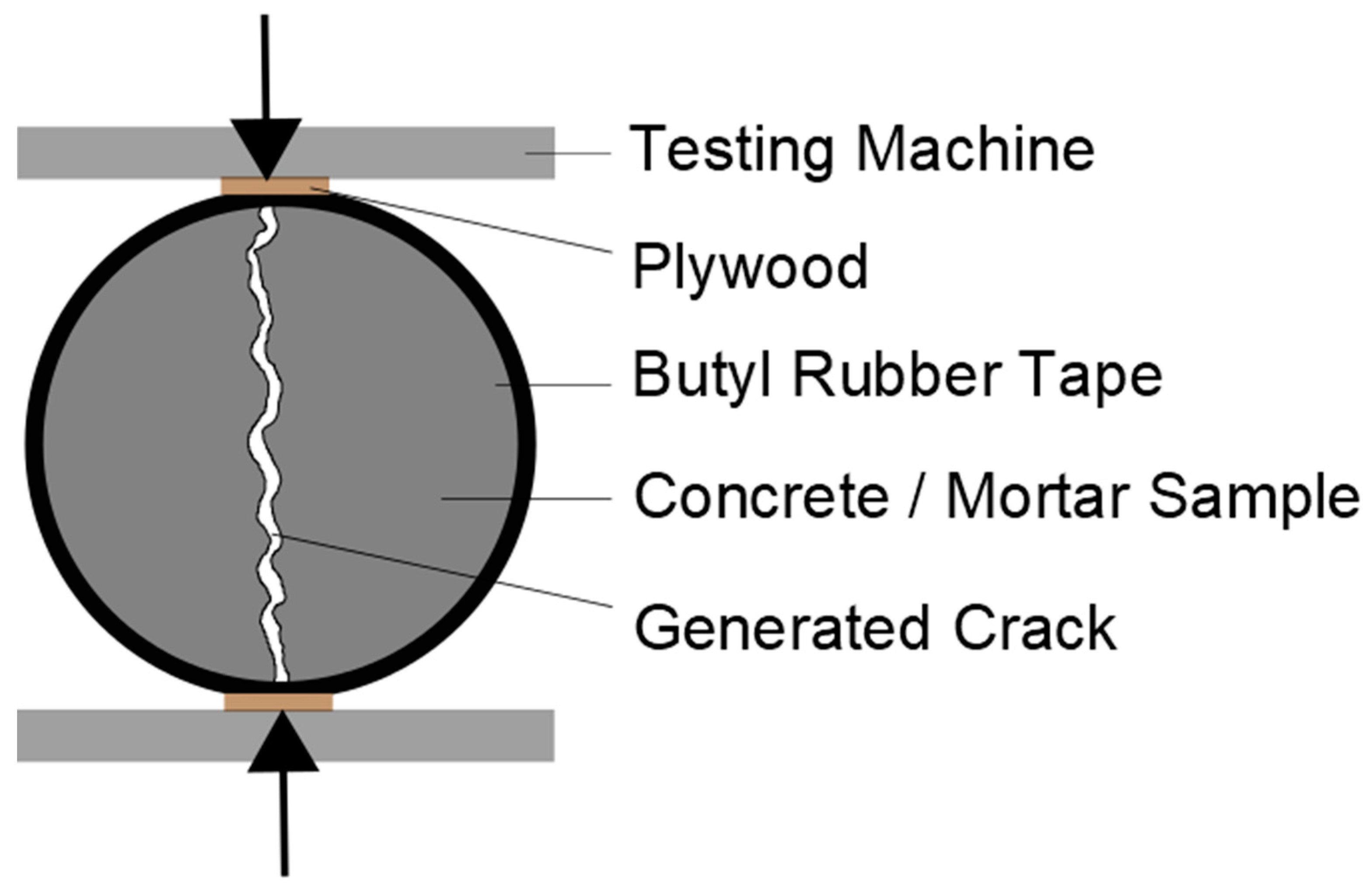
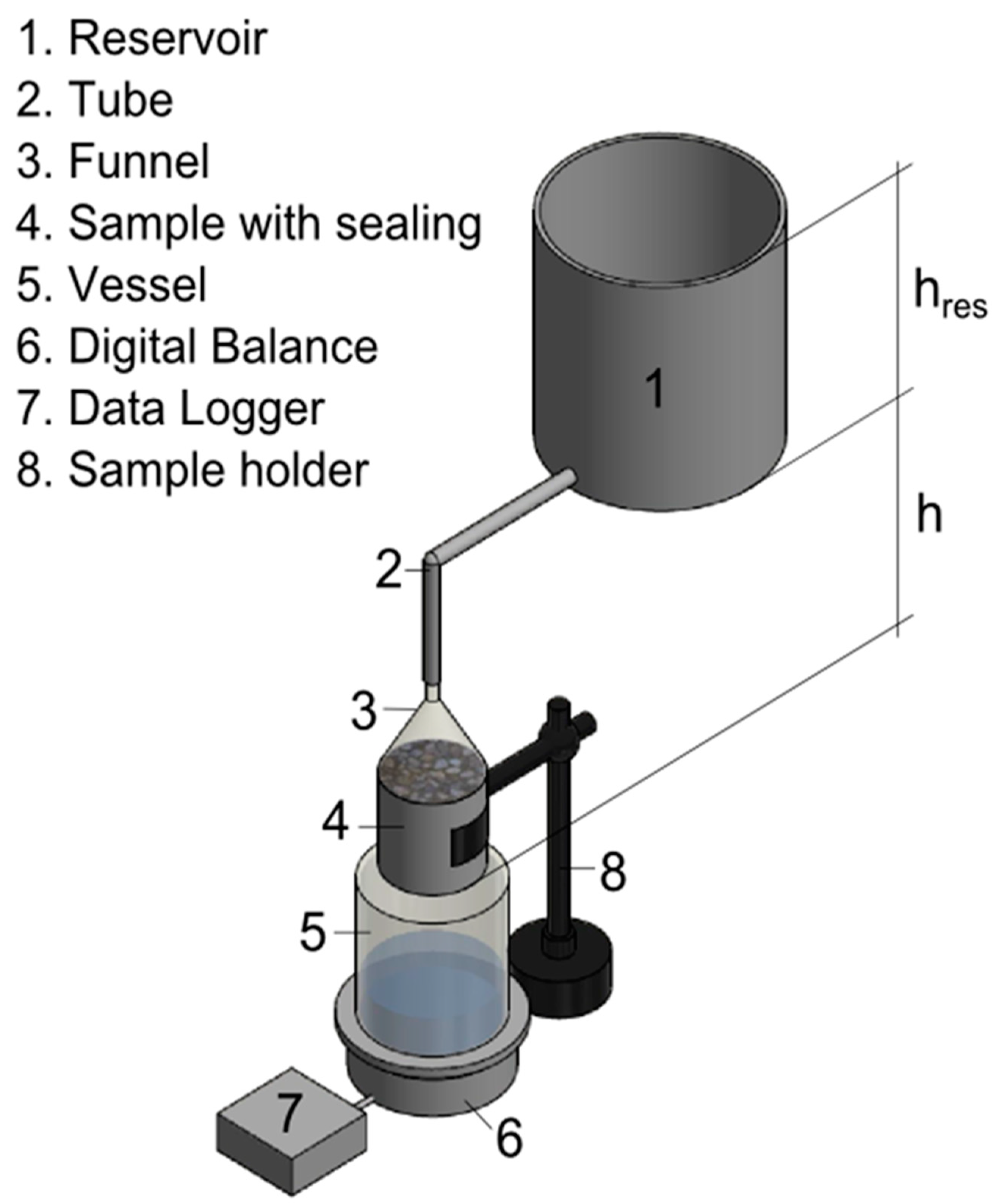

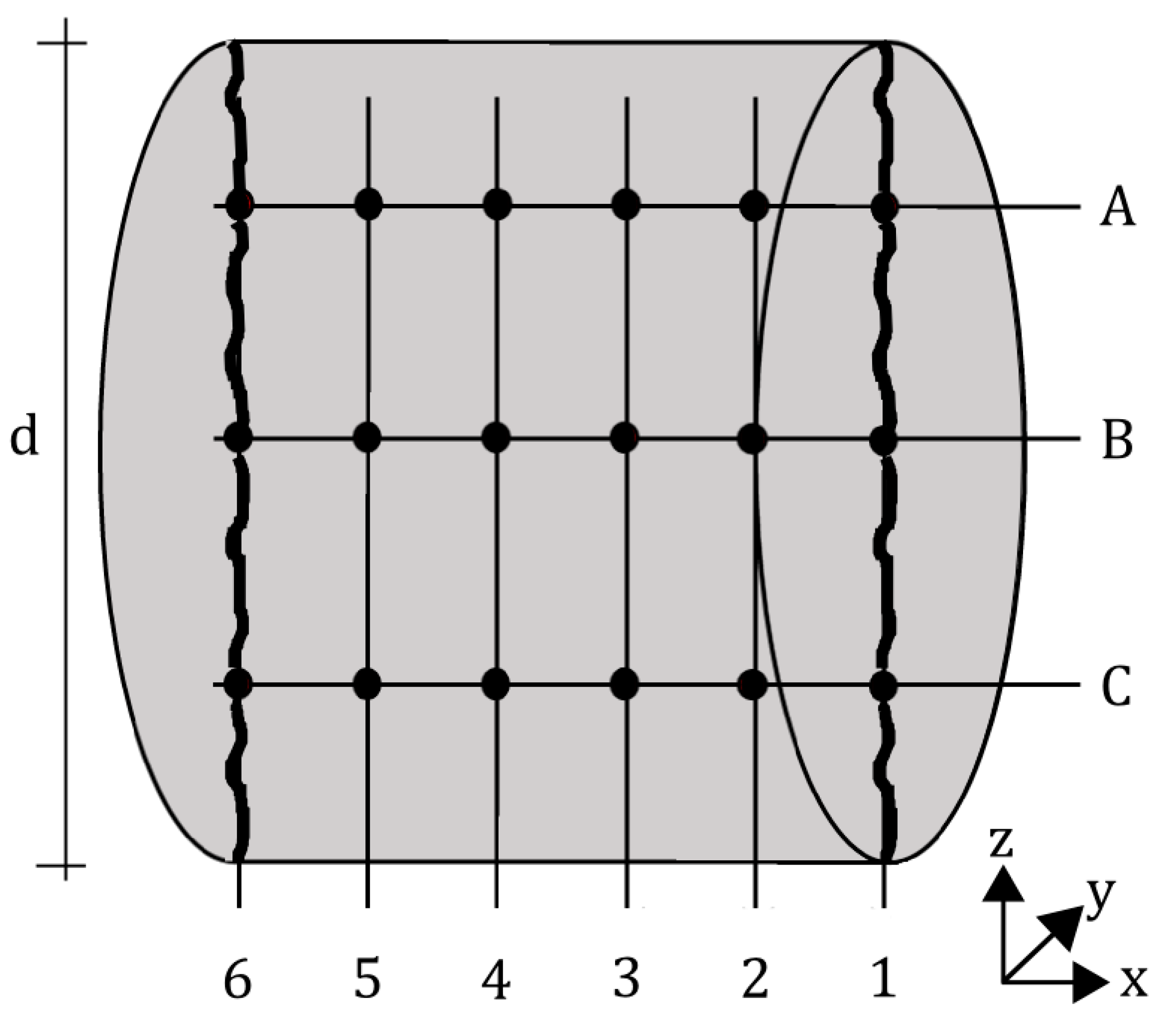
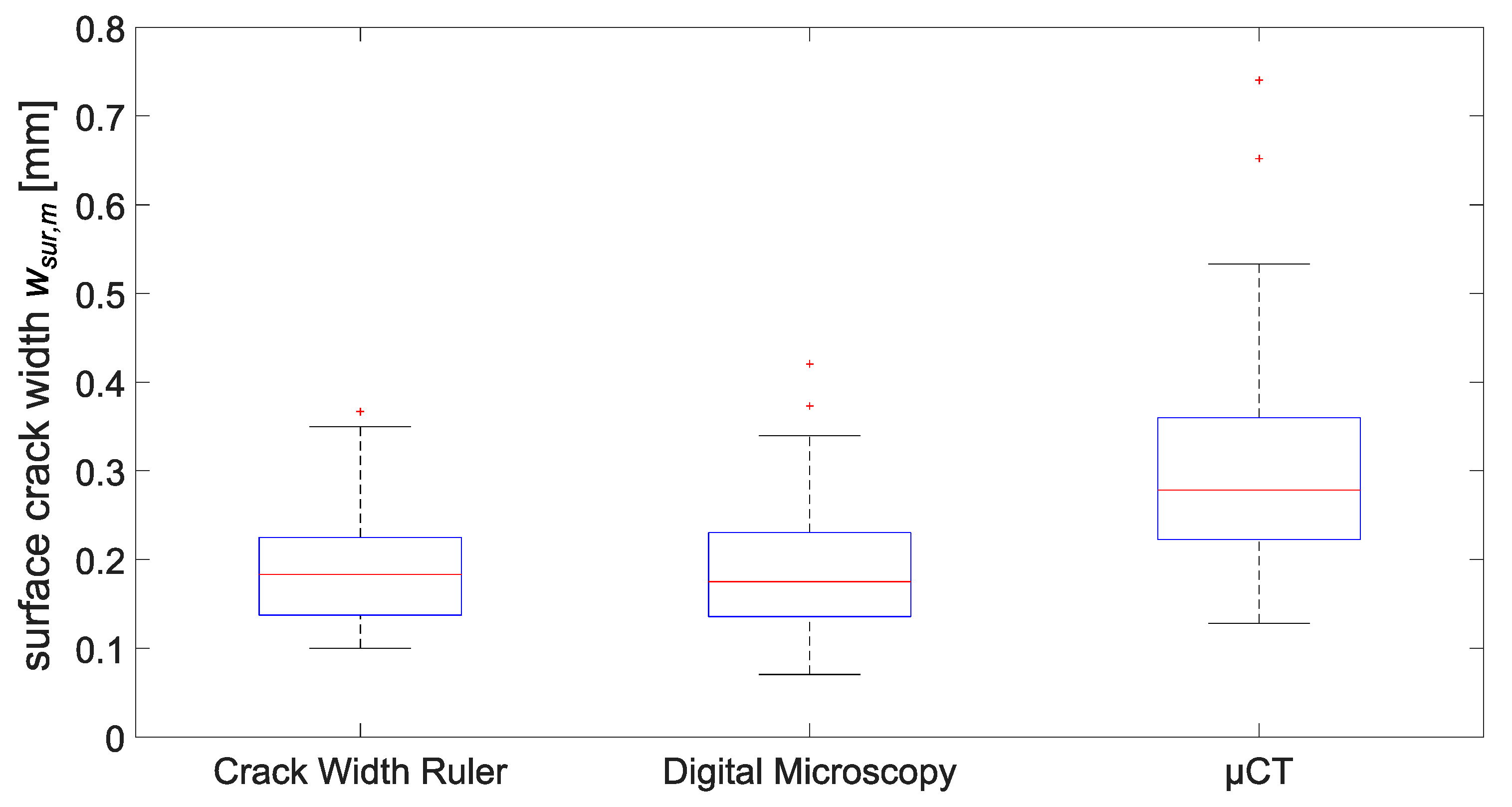


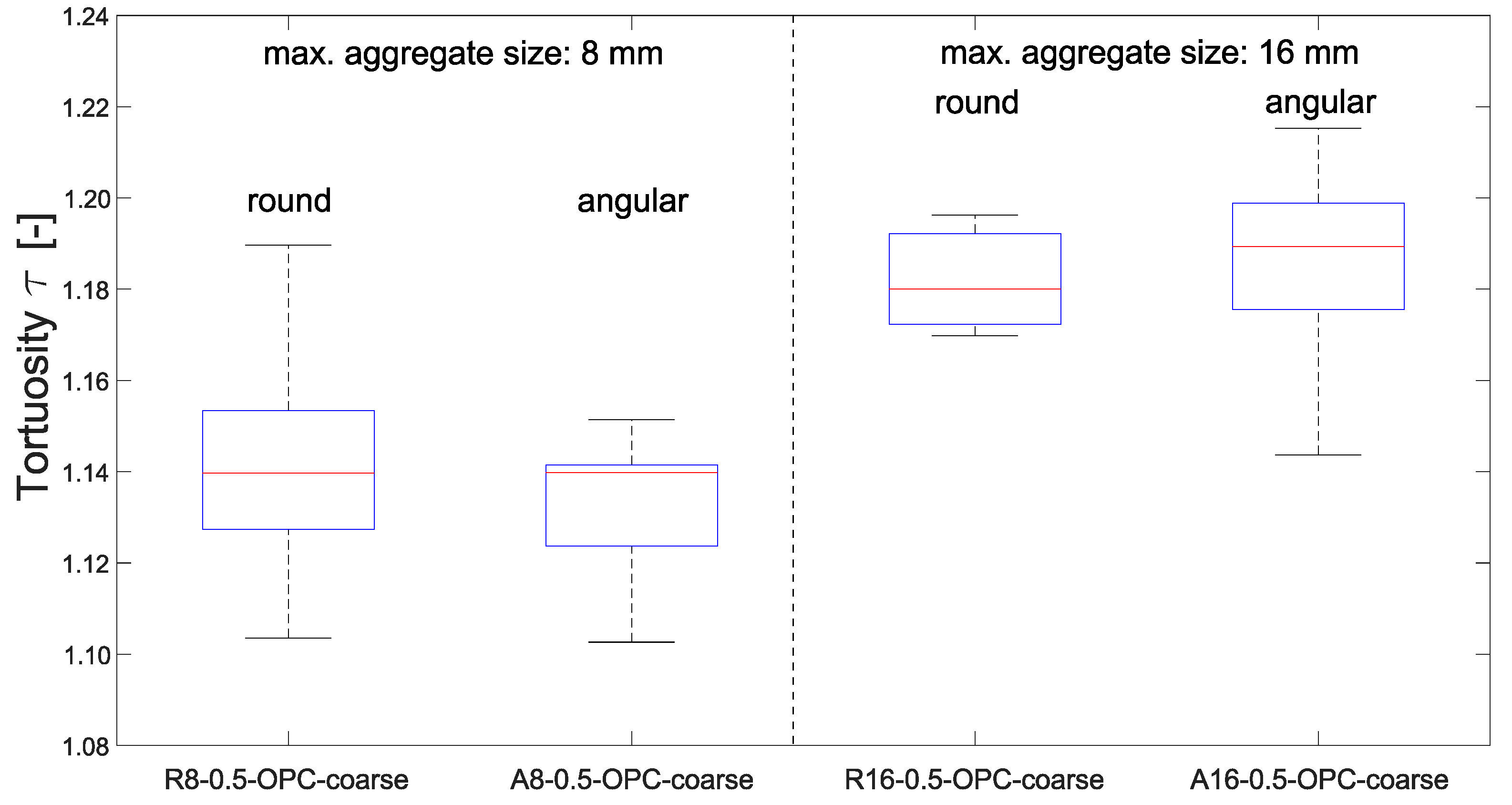
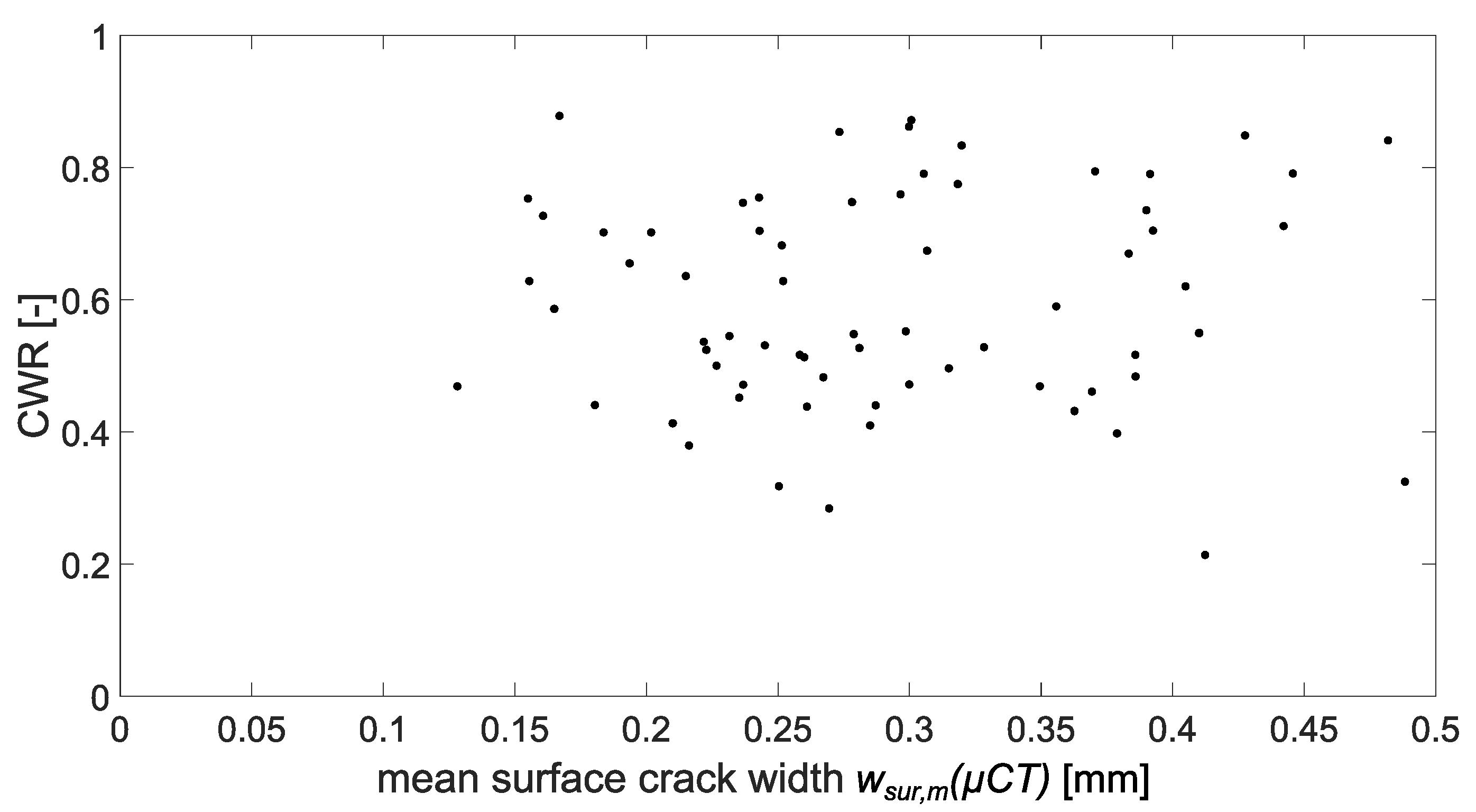

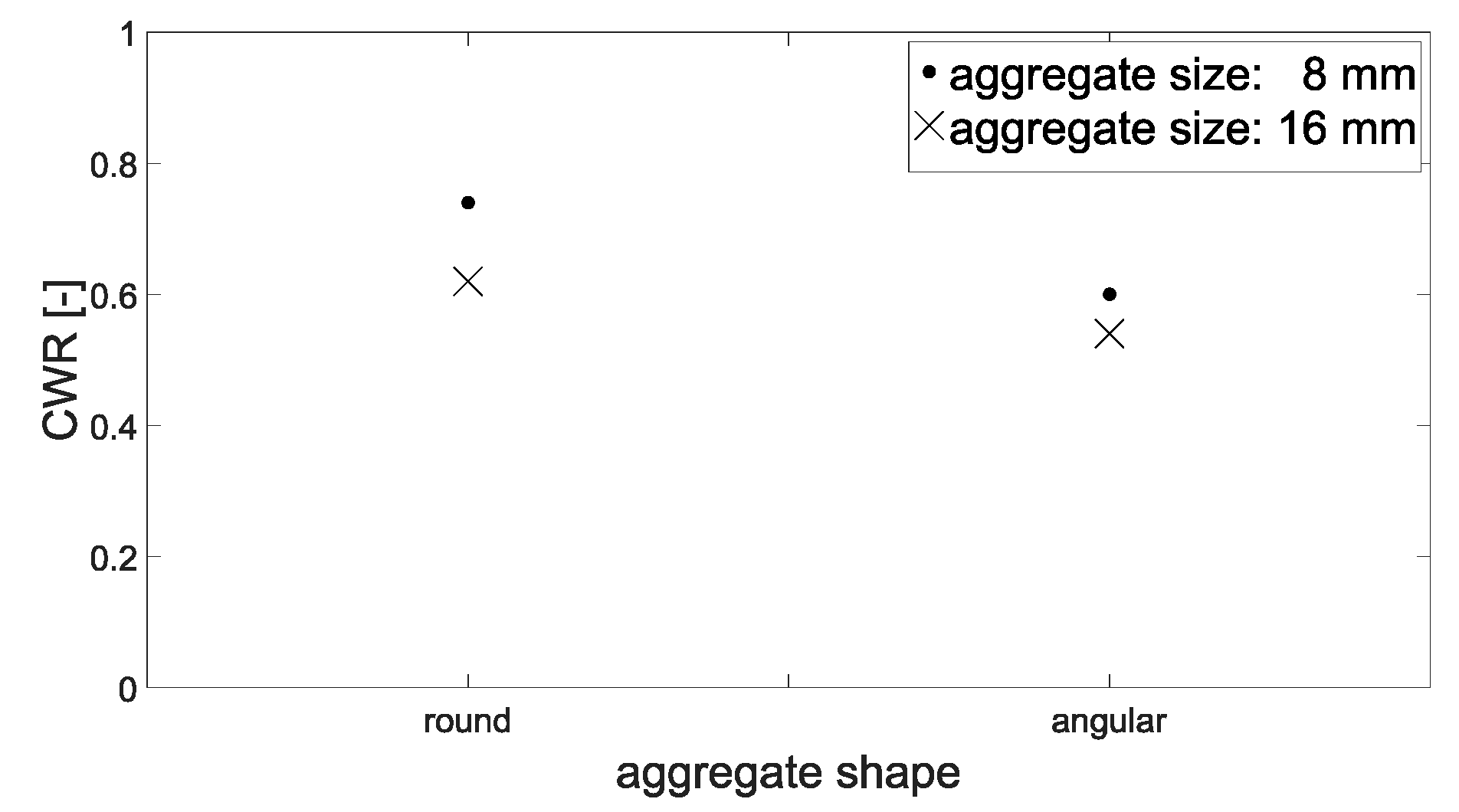

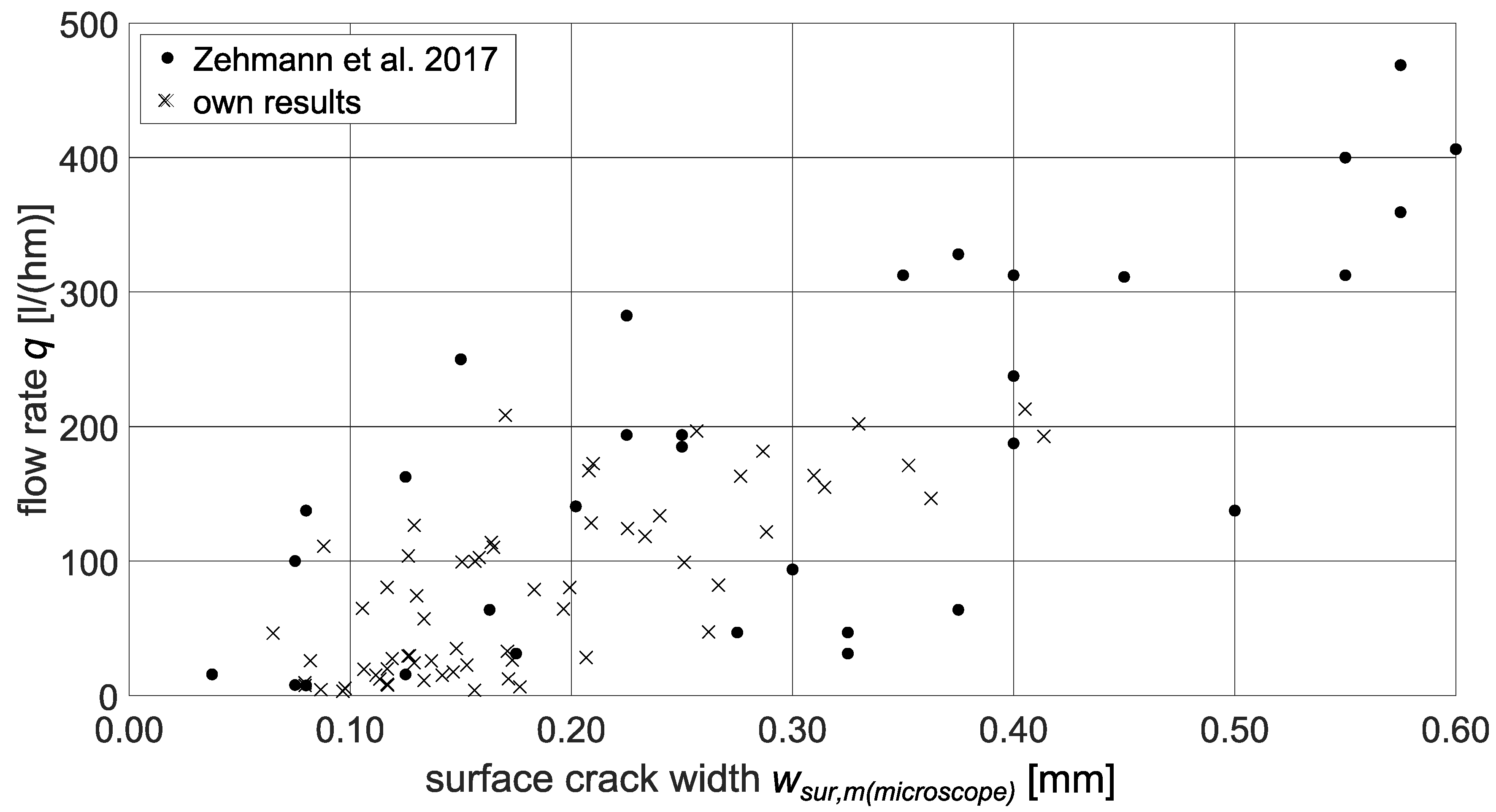
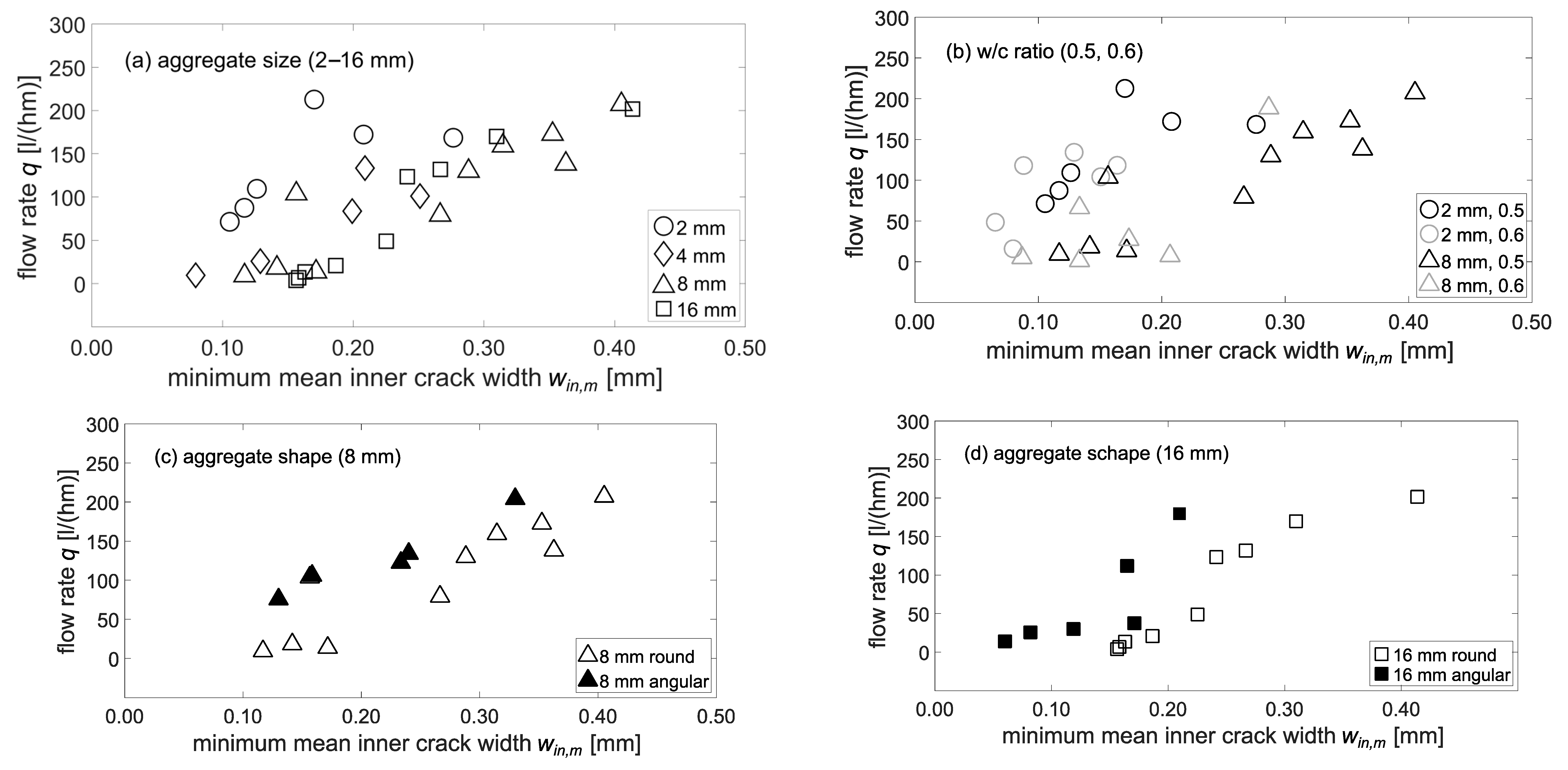
| Mix | Cement [kg/m3] | Water [kg/m3] | Agg. [kg/m3] | Agg. [vol.%] | dmax [mm] | Sieve Curve | w/c-Ratio | Cement Type | Adm. |
|---|---|---|---|---|---|---|---|---|---|
| R2-0.5-OPC | 586 | 293 | 1758/R | 51.8 | 2 | standard sand | 0.5 | OPC | - |
| R2-0.6-OPC | 586 | 352 | 1758/R | 54.9 | 2 | standard sand | 0.6 | OPC | - |
| R4-0.5-OPC-coarse | 476 | 238 | 1412/R | 59.4 | 4 | coarse | 0.5 | OPC | - |
| R8-0.5-OPC-coarse | 370 | 185 | 1613/R | 68.1 | 8 | coarse | 0.5 | OPC | - |
| R8-0.5-BFSC-coarse | 434 | 217 | 1488/R | 68.1 | 8 | coarse | 0.5 | BFC | - |
| R8-0.6-OPC-coarse | 305 | 183 | 1668/R | 70.4 | 8 | coarse | 0.6 | OPC | - |
| A8-0.5-OPC-coarse | 396 | 195 | 1995/C | 65.9 | 8 | coarse | 0.5 | OPC | SP |
| R8-0.5-OPC-fine | 390 | 195 | 1643/R | 66.42 | 8 | fine | 0.5 | OPC | - |
| R16-0.5-OPC-coarse | 370 | 185 | 1721/R | 68.07 | 16 | coarse | 0.5 | OPC | - |
| R16-0.5-BFSC-corase | 370 | 185 | 1721/R | 62.7 | 16 | coarse | 0.5 | BFC | - |
| A16-0.5-OPC-coarse | 370 | 185 | 1990/C | 68.1 | 16 | coarse | 0.5 | OPC | SP |
| Mix Notation | Median | 25th Percentile | 75th Percentile | Minimum | Maximum |
|---|---|---|---|---|---|
| R2-0.5-OPC | 1.10 | 1.08 | 1.11 | 1.08 | 1.11 |
| R2-0.6-OPC | 1.11 | 1.10 | 1.12 | 1.07 | 1.13 |
| R4-0.5-OPC-coarse | 1.13 | 1.12 | 1.14 | 1.11 | 1.14 |
| R8-0.5-OPC-coarse | 1.14 | 1.13 | 1.15 | 1.10 | 1.19 |
| R8-0.5-BFSC-coarse | 1.15 | 1.14 | 1.15 | 1.13 | 1.16 |
| R8-0.6-OPC-coarse | 1.18 | 1.17 | 1.19 | 1.16 | 1.21 |
| A8-0.5-OPC-coarse | 1.14 | 1.12 | 1.14 | 1.10 | 1.15 |
| R8-0.5-OPC-fine | 1.14 | 1.12 | 1.15 | 1.10 | 1.16 |
| R16-0.5-OPC-coarse | 1.18 | 1.17 | 1.19 | 1.17 | 1.20 |
| R16-0.5-BFSC-coarse | 1.19 | 1.17 | 1.27 | 1.16 | 1.37 |
| A16-0.5-OPC-coarse | 1.19 | 1.18 | 1.20 | 1.14 | 1.22 |
Publisher’s Note: MDPI stays neutral with regard to jurisdictional claims in published maps and institutional affiliations. |
© 2022 by the authors. Licensee MDPI, Basel, Switzerland. This article is an open access article distributed under the terms and conditions of the Creative Commons Attribution (CC BY) license (https://creativecommons.org/licenses/by/4.0/).
Share and Cite
Mengel, L.; Krauss, H.-W.; Lowke, D. Water Transport through Cracked Concrete Structures—Effect of Mixture Proportion on Separating Crack Geometry and Permeability. Materials 2022, 15, 5807. https://doi.org/10.3390/ma15175807
Mengel L, Krauss H-W, Lowke D. Water Transport through Cracked Concrete Structures—Effect of Mixture Proportion on Separating Crack Geometry and Permeability. Materials. 2022; 15(17):5807. https://doi.org/10.3390/ma15175807
Chicago/Turabian StyleMengel, Lena, Hans-Werner Krauss, and Dirk Lowke. 2022. "Water Transport through Cracked Concrete Structures—Effect of Mixture Proportion on Separating Crack Geometry and Permeability" Materials 15, no. 17: 5807. https://doi.org/10.3390/ma15175807






